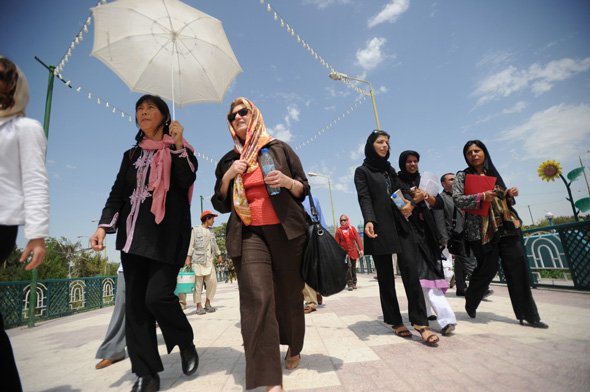-
Ambassador Melanne Verveer, U.S. Department of State
Ambassador-at-Large for Global Women’s Issues on Durban and the Role of Women in Combating Climate Change
›December 23, 2011 // By Wilson Center StaffThe original version of this article, by Ambassador Melanne Verveer, appeared on the White House Council on Environmental Quality blog.
Last week I traveled to Durban, South Africa to participate in the Conference of the Parties to the United Nations Framework Convention on Climate Change to highlight the critical and largely untapped potential of women to combat climate change. Studies have shown that it is often women who are on the frontlines of, and suffer disproportionately from, the impacts of climate change. This is certainly important. But we must remember that women are also a powerful force for finding solutions to climate change across the board, including in areas such as agriculture, sustainable forest management, and energy access.
Agriculture, which accounts for approximately 14 percent of global greenhouse gas emissions and is a sector that can be particularly sensitive to climate variability and change, is one key area where women can play a major role. A recent FAO report shows that women, in many places, are the main producers of the world’s staple crops, particularly in developing countries and regions likely to be adversely affected by climate change impacts. However, globally, only a small minority of women farmers have access to land tenure. This is a problem for many reasons – including that it limits women’s potential to combat climate change. Studies have shown that women with the right to property are significantly more capable of investing in climate-smart agricultural productivity; we have a lot of work to do to unlock women’s potential in this area.
Women also have untapped potential for increasing energy access, which directly relates to climate change. For example, nearly three billion people globally still rely on traditional cookstoves and open fires to prepare food for their families. In most instances, women are responsible for cooking – not to mention also spending many hours per week collecting fuel, which often puts women at risk of gender based violence. The resulting smoke exposure causes an estimated two million premature deaths annually, with women and young children the most affected. Cookstoves also impact the climate through emissions of greenhouse gases and short-lived particles such as black carbon. Engaging women is critical to tackling this problem. As we work to build a global market for clean cookstoves, integrating women into the cookstoves supply chain will help increase clean cookstove adoption rates while also creating new economic development opportunities. And as Secretary Clinton has noted, women create a multiplier effect in local communities because they disproportionately spend more of their earned income on food, healthcare, home improvement, and schooling.
The United States recognizes the power of women’s potential in these areas and many others, and is investing in major initiatives including Feed the Future and the Global Alliance for Clean Cookstoves, where women’s role in generating transformative change is front and center.
I went to Durban to highlight the critical role of women in combating climate change. While there, I worked with U.S. negotiators on the Durban texts and participated in public engagement events. Our efforts to build on the gender equality and women’s empowerment language in the Cancun agreements are reflected in several crucial institutional developments, including language on gender balance related to the composition of the board of the new Green Climate Fund, the Standing Committee, and the Adaptation Committee. We also worked to reflect gender considerations in the mission of the Climate Technology Center and Network. USAID Assistant Administrator Eric Postel and I solicited input during a meeting with leading non-governmental organizations working on gender and climate issues, and I hosted a high-level side event at the U.S. Center focused on unlocking women’s potential to combat climate change. The level of enthusiasm among my fellow panelists and the audience at the event was inspirational.
We made progress in Durban, but we can’t stop here. To achieve the future we all seek, we must do more. As the late Wangari Maathai, founder of the Green Belt Movement and ground-breaking advocate on women and the environment said, “We must not tire, we must not give up, we must persist.” The future of not only women, but our planet, depends on it.
Ambassador Melanne Verveer is U.S. Ambassador-at-Large for Global Women’s Issues.
Sources: Food and Agriculture Organization, Intergovernmental Panel on Climate Change, The White House.
Photo Credit: “Melanne S. Verveer,” courtesy of the U.S. Embassy, Kabul. -
Climate Diplomacy in Perspective
›December 20, 2011 // By Lukas RüttingerClimate policy on the international level often seems to be largely limited to negotiations within the United Nations Framework Convention on Climate Change (UNFCCC). However, in the shadow of these negotiations, a new approach merging climate and foreign policy is developing. Calling it “climate diplomacy,” proponents of this approach argue that tackling climate change is inherently a political struggle and one in which classic diplomatic instruments should play a role. This is especially true, since the challenges posed by climate change are so huge and the solutions so far reaching that the climate conversation also has to be a diplomatic one. Yet negotiations and treaties are just one instrument of foreign policy and they are only as successful and strong as the political foundation upon which they are built.
The German Federal Foreign Office, supported by adelphi, invited representatives from the European Union, the Organization for Security and Cooperation in Europe, and the United Nations, as well as over 30 countries for a two-day conference in Berlin this October, “Climate Diplomacy in Perspective – From Early Warning to Early Action,” to discuss what climate diplomacy looks like in practice, what its added value is, and what challenges it is best suited to address.
In working groups on water diplomacy, food security, and coastal stability, common themes and questions quickly emerged. In particular, the value and danger of securitizing the climate change discourse was a prominent issue.
On the one hand, the securitization of issues such as transnational water sharing can raise threat perception to a level that makes it very hard to tackle and may even foster conflict. On the other hand, participants noted that framing climate change as a security challenge might help to finally create the political leverage needed for far-reaching action.
Confronting Complexity
Another common theme was the complexity and linked nature of the climate challenges faced. Although covering different aspects, each working group quickly recognized systems with multiple feedback loops, such as the water-food-energy nexus. The same point was underlined in discussions around complex emergencies and crises, such as the 2010 floods in Pakistan.
However, the discussion did not stop at an analysis of challenges, the working groups also developed many suggestions of what climate diplomacy could and should look like.
One shared recommendation was that the complexity of and links between issues require sectoral policies and institutions to reach beyond their traditional, thematic, and even geographic focus. In regards to cross-border water cooperation, for example, this means that regional political institutions are often better suited than water institutions because of their broader mandate and focus. Where classic diplomacy and regional cooperation do not work, for example because national governments are blocking these efforts, participants proposed that informal diplomacy, track two initiatives, and cooperation on lower administrative levels such as municipalities can provide alternatives.
The complexity of the challenges is daunting but when asked to summarize why diplomats should tackle climate change, John Ashton, the special representative for climate change for the British Commonwealth Foreign Office, summed up his understanding in a simple but to-the-point answer: “Because it is our job.”
Lukas Rüttinger is a project manager for adelphi, mainly focusing on the fields of conflict analysis and peacebuilding as well as resources and governance.
Photo Credit: German Federal Foreign Office. -
The Legacy of Little America: Aid and Reconstruction in Afghanistan
›In 2007, the United States built a $305 million diesel power plant in Afghanistan – the world’s most expensive power plant of its kind. Yet the facility is rarely used, because the impoverished country cannot afford to operate it.
This ill-fated power plant does not represent the only time America has lavished tremendous amounts of money on development projects in Afghanistan that have failed to meet objectives. At a December 7 presentation organized by the Wilson Center’s Asia Program and co-sponsored with the Middle East Program and International Security Studies, Rajiv Chandrasekaran discussed Washington’s expensive attempts to modernize southern Afghanistan’s Helmand River Valley from the 1940s to 1970s – and the troubling implications for U.S. development projects in that country today.
From Morrison Knudsen to USAID
According to Chandrasekaran, a Wilson Center Public Policy Scholar and Washington Post journalist, the story begins after World War II, when Afghanistan’s development-minded king, Zahir Shah, vowed to modernize his country. He hired Morrison Knudsen – an American firm that had built the Hoover Dam and the San Francisco Bay Bridge – to construct irrigation canals and a large dam on the Helmand River. Shah’s view was that by making use of the Hindu Kush’s great waters, prosperity would emerge and turn a dry valley into fertile ground.
Unfortunately, problems arose from the start. The region’s soil was not only shallow, but also situated on a thick layer of subsoil that prevented sufficient drainage. When the soil was irrigated, water pooled at the surface and salt accumulated heavily. Yet despite these challenges, King Shah was determined to continue the massive enterprise. And so, increasingly, was the U.S. government – particularly when Washington began to fear that if it did not support this project, the Soviets would.
In 1949, the United States provided the first installment of what would amount to more than $80 million over a 15-year period. With this aid in hand, Morrison Knudsen not only completed the canals and dam but also constructed a new modern community. Americans called the town Lashkar Gah, but Afghans christened it “Little America.” It boasted a movie theater, a co-ed swimming pool, and a tennis court. Children listened to Elvis Presley records, drank lemonade, and learned English at Afghanistan’s only co-ed school.
However, problems continued to proliferate. Afghans in Lashkar Gah – many of whom had been lured away from their ancestral homelands on the promises of better harvests – did not experience greater farm yields. In the 1960s, the Afghans severed their contract with Morrison Knudsen, and began working directly with U.S. government agencies, including the new U.S. Agency for International Development (USAID). The result was some fairly productive farms, but, due in great part to waterlogging and soil salinity, the objective of transforming the region into Afghanistan’s breadbasket was not attained. U.S. funding slowed in the 1970s, and the grand experiment officially ended in 1978, when all Americans pulled out of Lashkar Gah following a coup staged by Afghanistan’s Communist Party.
“We Need To Find a Middle Ground”
What implications does all this have for U.S. reconstruction efforts in Afghanistan today? Chandrasekaran offered several lessons for American policymakers. One is “beware the suit-wearing modern Afghan” who claims to speak for his less-development-inclined countrymen. Another is to be aware that “there is only so much money that the land can absorb.” Finally, it is unrealistic to expect patterns of behavior to change quickly; he noted how Afghans in Lashkar Gah continued to flood their fields even when advised not to do so.
These lessons are not being heeded today, according to Chandrasekaran. He cited a USAID agricultural project, launched in late 2009, that allocated a whopping $300 million to just two provinces annually, with $30 million spent over only a few months. He said that while this effort may have generated some employment, the immense amounts of money at play fueled tensions among Afghans. Furthermore, contended Chandrasekaran, the program “focused too much on instant gratification and not on building an agricultural economy.”
In conclusion, Chandrasekaran insisted that foreign aid is essential in Afghanistan (and at the recently concluded Bonn Conference, Afghan President Hamid Karzai agreed, calling for financial assistance to continue until 2030). He described past aid efforts as either “starving the patient” or “pumping food into him.” We need to find a middle ground, he argued, and said that working on more modest projects with small Afghan nongovernment organizations is one possibility. The problem, he acknowledged, is that Washington is under pressure to spend ample quantities of money, and therefore depends on large implementing partners – no matter the unsatisfactory results.
Michael Kugelman is program associate with the Asia Program at the Wilson Center. -
Watch ‘Mother Jones’’ Kate Sheppard on Covering the Evolving Environment and Reproductive Rights Beat
› “My author bio says I cover energy, environment, and reproductive rights,” said Kate Sheppard of Mother Jones in an interview with ECSP. “One of the biggest challenges in covering that beat is even just articulating what that means.”
“My author bio says I cover energy, environment, and reproductive rights,” said Kate Sheppard of Mother Jones in an interview with ECSP. “One of the biggest challenges in covering that beat is even just articulating what that means.”
Fundamentally, Sheppard said she is interested in covering how policy decisions shape the future, which involves examining the intersections between these key issues. She spoke at a November 1 Wilson Center event on the challenges of reporting on population and environment, especially this year, when a great deal of media covered the world population reaching seven billion.
Sheppard is currently reporting on adaptation to climate change, looking at how human societies are responding to the changes that they are already experiencing, whether it be changes in migration patterns, resource availability, or food security. “I’m seeing this as a really ripe area where these things intersect, when we are talking about just how many people we are going to have in the future, and where they are going to be, and whether we can meet their needs in a society that is constantly changing,” she said.
Energy is another important area of intersection, said Sheppard. Access to energy is critical to ensuring a better future for the world’s inhabitants, but policy decisions must also take into account the fact that our fossil fuel resources are finite, she said. “We need to start thinking about ways we are going to do this sustainably for the world population in the future.” -
The Yasuní-ITT Initiative Is a Practical Climate Solution That Must Be Embraced at Durban
›
As the world turns to Durban, South Africa, for this year’s UN climate summit, new findings are turning up the heat on the urgency to address climate change. The reality though is that we no longer have the luxury of resting our hopes solely on an internationally binding climate agreement; we must begin to look more closely at supporting immediate and tangible solutions. By complementing a global top-down effort of continued international negotiations with bottom-up approaches, we increase our chances at mitigating the most damaging effects of climate change. One of the most innovative models of such a bottom-up approach is the Yasuní-ITT Initiative being undertaken by the Government of Ecuador and supported by the UN Development Programme’s Multi-Partner Trust Fund Office (MPTF Office).
-
Supply and Demand, Land and Power in the Global South
›In “Competition over Resources: Drivers of Insecurity and the Global South,” author Hannah Brock examines how an increased demand for non-renewable resources could lead to insecurity and contribute to local and international discord. The first of four papers examining what the Oxford Research Group has identified as the “most important underlying drivers of insecurity,” the paper focuses on competition over resources – specifically energy, water, and food – and argues that “a new way of approaching security is needed, one that addresses the drivers of conflict: ‘curing the disease’ rather than ‘fighting the symptoms.’” Through numerous examples, Brock illustrates the various strategies that nations are currently undertaking to satisfy demand and cautions that “where northern states and corporations buy access to southern resources, regulatory principles may be required to ensure this competition does not impair the human rights and security of local populations.”
A new briefing paper from Oxfam, “Land and Power: The growing scandal surrounding the new wave of investments in land,” heavily criticizes the rising trend of foreign land acquisitions, or “land grabs,” that have occurred since the 2007-08 food prices crisis, calling them an infringement on the rights of more vulnerable populations and decrying their environmental impact. The authors use case studies in Uganda, Indonesia, Guatemala, Honduras, and South Sudan to argue that land grabbing is a type of “development in reverse.” “National governments have a duty to protect the rights and interests of local communities and land rights-holders,” Oxfam writes, “but in the cases presented here, they have failed to do so.” The authors conclude with recommendations to improve transparency and shift power more towards local rights. -
Robert Olson for the Science and Technology Innovation Program
Geoengineering for Decision Makers
›Download Geoengineering for Decision Makers, by Robert Olson, from the Wilson Center. Excerpted below is the executive summary.
Geoengineering involves intentional, large-scale interventions in the Earth’s atmosphere, oceans, soils or living systems to influence the planet’s climate. Geoengineering is not a new idea. Speculation about it dates at least to 1908, when Swedish scientist Svente Arrhenius suggested that the carbon dioxide released from burning fossil fuels might help prevent the next ice age. Until recently, proposals for using geoengineering to counteract global warming have been viewed with extreme skepticism, but as projections concerning the impact of climate change have become more dire, a growing number of scientists have begun to argue that geoengineering deserves a second look.
Below are 10 of the major concerns about geoengineering that policymakers need to be aware of and give due consideration. These concerns apply mainly to solar radiation management (SRM), the form of geoengineering that attempts to cool the climate by reflecting a small amount of solar radiation back into space. SRM involves significantly higher risks than the other form of geoengineering, carbon dioxide removal (CDR) which involves removing carbon dioxide from the atmosphere and storing it in the ocean, plants, soil, or geological formations.- Unintended Negative Consequences: We may know too little about the Earth’s geophysical and ecological systems to be confident we can engineer the climate on a planetary scale without making an already bad situation even worse;
- Potential Ineffectiveness: Some proposed CDR methods are so weak that they would produce useful results only if sustained on a millennial timescale;
- Risk of Undermining Emissions-Mitigation Efforts: If politicians come to believe that geoengineering can provide a low-cost “tech fix” for climate change, it could provide a perfect excuse for backing off from efforts to shift away from fossil fuels;
- Risk of Sudden Catastrophic Warming: If geoengineering is used as a substitute for emissions reduction, allowing high concentrations of CO2 to build up in the atmosphere, it would create a situation where if the geoengineering ever faltered because of wars, economic depressions, terrorism or any other reasons during the millennium ahead, a catastrophic warming would occur too quickly for human society and vast numbers of plant and animal species to adapt;
- Equity Issues: Geoengineering efforts might succeed in countering the warming trend on a global scale, but at the same time cause droughts and famines in some regions;
- Difficulty of Reaching Agreement: It could be harder to reach global agreements on doing geoengineering than it is to reach agreements on reducing carbon emissions;
- Potential for Weaponization: Geoengineering research could lead to major advances in knowledge relevant for developing weather control as a military tool;
- Reduced Efficiency of Solar Energy: For every one percent reduction in solar radiation caused by the use of SRM geoengineering, the average output of concentrator solar systems that rely on direct sunlight will drop by four to five percent;
- Danger of Corporate Interests Overriding the Public Interest: Dangers include a lack of transparency in SRM technology development and the possibility that the drive for corporate profits could lead to inappropriate geoengineering deployments;
- Danger of Research Driving Inappropriate Deployment: Research programs have often created a community of researchers that functions as an interest group promoting the development of the technology that they are investigating.
Several of the best climate studies suggest that stabilizing the amount of carbon dioxide and other greenhouse gases below the level that risks dangerous climate change will require a social mobilization and technological transformation at a speed and scale that has few if any peacetime precedents. If correct, and the needed mobilization does not occur in the years immediately ahead, then decision makers later in the century could find themselves in a situation where geoengineering is the only recourse to truly dangerous climate change. The most fundamental argument for R&D; on geoengineering is that those decision makers should not be put in a position of either letting dangerous climate change occur or deploying poorly evaluated, untested technologies at scale. At the very least, we need to learn what approaches to avoid even if desperate.
Continue reading by downloading the full report from the Wilson Center.
Robert Olson is a Senior Fellow at the Institute for Alternative Futures. -
New Report Launched: ‘The World’s Water’, Volume Seven
›“The water problem is real and it is bad,” said MacArthur “Genius” Fellow and founder of the Pacific Institute Peter Gleick at the October 18 launch of the seventh volume the institute’s biennial report on freshwater resources. “It’s not bad everywhere, and it’s not bad in the same way from place to place, but we are not doing what we need to do to address all of the different challenges around water.”
“The World’s Biggest Problem”
Worldwide, more than a billion people lack access to safe drinking water, while two and a half billion lack access to adequate sanitation services. “This is the world’s biggest water problem,” said Gleick, “the failure to meet basic human needs for water – it’s inexcusable.”
Gleick predicts that the world will fail to meet the Millennium Development Goals for water and sanitation by 2015, and noted that measures of illness for water-related diseases are rising, rather than falling.The World’s Water series provides an integrated way of thinking about water by exploring major concepts, important data trends, and case studies that point to policies and strategies for sustainable use of water. Volume seven includes chapters on climate change and transboundary waters, corporate water management, water quality challenges, Australia’s drought, and Chinese and U.S. water policy. The new volume also includes a set of side briefs on the Great Lakes water agreement, the energy required to produce bottled water, and water in the movies, as well as 19 new and updated data tables. An updated water conflict chronology looks at conflicts over access to water, attacks on water, and water used as a weapon during conflict.Peter Gleick on climate change and the water cycle.
Despite the added data, Gleick said that vast gaps remain in our knowledge and understanding about water. We lack accurate information on how much water the world has, where it is, how much humans use, and how much ecosystems need, he said. “So right off the bat, we are at a disadvantage.”
Focus on Efficiency, Infrastructure to Better Manage Water
One of the major concepts that has connected various volumes of The World’s Water is the concept of a “soft path for water” – a strategy for moving towards a more sustainable future for water through several key focus points: improved efficiency, decentralized infrastructure, and broadly rethinking water usage and supply.
Other cross-cutting themes include climate and water, peak water, environmental security, and the human right to water (formally recognized in a 2010 UN General Assembly resolution). “I would argue that all of these combined offer to some degree a different way of thinking about water, an integrated way of thinking about water,” Gleick said.
The China Issue
The role of China has been one of the most significant changes over the course of the series, said Gleick. The growth in the Chinese economy has led to a massive growth in demand for water (see the Wilson Center/Circle of Blue project, Choke Point: China), as well as massive contamination problems. The newest volume addresses these issues as well as China’s dam policies – internally, with neighboring countries, and around the world.
Gleick pointed out that China is one of the only nations (maybe the only) that still has a massive dam construction policy, and their installed capacity is already much larger than the United States, Brazil, or Canada. In addition, Chinese companies and financial interests are involved in at least 220 major dam projects in 50 countries around world. These projects have become increasingly controversial, for both environmental and political reasons, he said.
“My lens is typically a water lens,” Gleick said, but “none of us can think about the problems we really care about, unless we think about a more integrated approach.” Gleick emphasized the need for new thinking about sustainable, scalable, and socially responsible solutions. “We have to do more than we are doing, in every aspect of water,” he concluded.
Event Resources
Photo Credit: “Water,” courtesy of flickr user cheesy42.
Showing posts from category energy.












